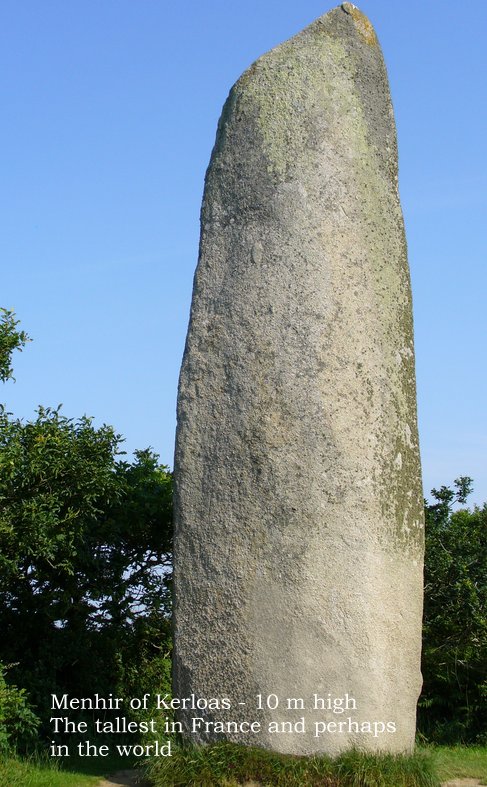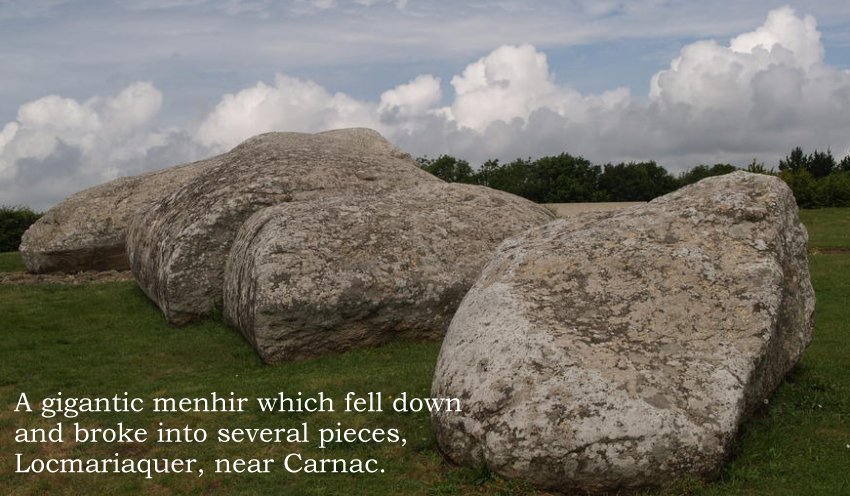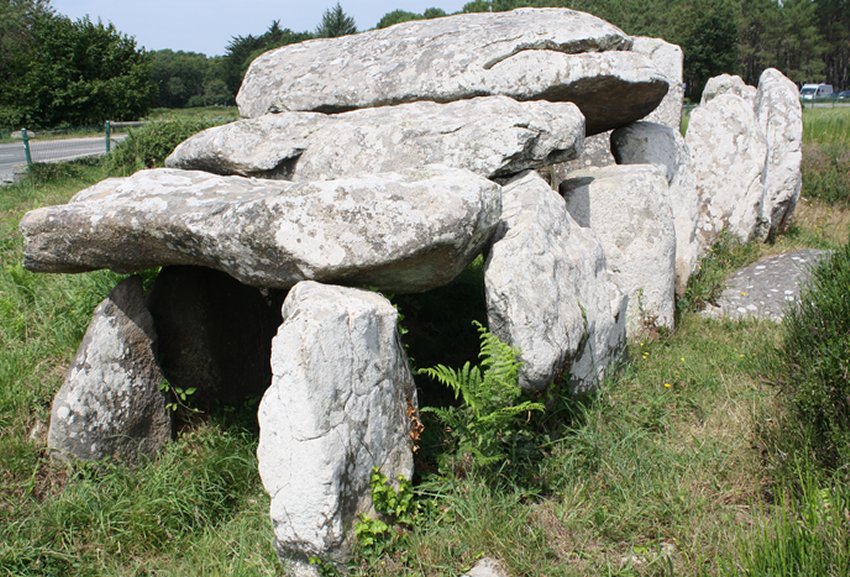Mysterious Megalithic Stones Of Carnac, France – An Unsolved Neolithic Enigma
A. Sutherland - AncientPages.com - Millennia ago, unknown Neolithic builders erected gigantic stone blocks on coastlines ranging from the Orkney Islands to far away in Jordan.
Examples of megaliths are to be found in almost all western European countries, and in addition in Africa, Spain, Palestine, on the northern shore of the Black Sea, in the Arabian Peninsula, and finally even in Tibet.
Was this a coincidence that this almost worldwide megalithic project started and was completed in the distant past? Why were they set up at that time? Where was the cradle of the culture that made this project successful?
"There is an overland trail of megalithic structures, which runs from the south of France to the English Channel. Was it a shortcut for the old maritime trade route which had to go round the Iberian peninsula?
This theory fits well into the picture of the colonization of Europe by people of the megalithic culture. It is also reinforced by the fact that in Carnac in Britany there are rows of stones that are identical to those in Gezer in Palestine, and that Egyptian pearls were found in the megalithic graves in Ireland." 1
More than 5000 years ago, single standing stones (menhirs) arranged in complex alignments, appeared at Carnac in southern Brittany, France.
Local tradition claims that the reason they stones in such perfectly arranged straight lines
is that they are a Roman legion turned to stone by Merlin. Naturally, Brittany has its own
local versions of the Arthurian cycle. The precise date of the stones is difficult to ascertain because very little dateable material has been found beneath them. Therefore, the site's main phase of activity is commonly attributed to about 3300 BC.
Carnac - with over 100 monuments, which include burial mounds, stone tombs, enclosures, and linear arrangements of menhir - is the site of the largest concentration of megalithic monuments in the world.
More than 5000 years ago, single standing stones (menhirs) arranged in complex alignments, appeared at Carnac in southern Brittany, France.
Carnac - with over 100 monuments, which include burial mounds, stone tombs, enclosures, and linear arrangements of menhir- is the site of the largest concentration of megalithic monuments in the world.
Many believe they have an astronomical function as a marker or foresight. Others think it's an enormous cemetery because passage graves are found here. Other researchers believe that the graves are all of a much more recent date than millennia-old menhirs.
Mysterious almost endless megalithic alleys of Carnac, once sacred to a vanished culture, have long influenced people's imagination.
Carnac consists of more than 3,000 megaliths - up to 13 feet (4m) in height in different circuits, groups, and a large number of independent stones. The different locations are more or less aligned in the Northeast / Southwest direction. The stones are cut out of a local quarry about three kilometers from the sites and dragged to the site.
All of these stone settlements were built in Neolithic times, probably between 4500 and 2500 BC. They are linked with pre-Celtic people who lived in the area. The function of the various stone sets is unclear, possibly based on astronomical calculations and having a religious significance. In many cases there are signs of vandalization in early Christian times, for example, rocks have been used to build churches.
Now, the prehistoric monument of Carnac covers approximately 2 miles (3km) along the French North Atlantic coastline, but originally it stretched even up to 5 miles (8km).
An unknown culture, a long time ago, toward the end of the Neolithic period, erected Carnac monuments and did it for a purpose. They were neither Romans nor the Gauls nor the Celts.
Will we ever know who they were? Nearly all the stones stand near the sea, so researchers made assumptions that those who set up the stone alleys of Carnac were seafaring people.
According to research done by Elizabeth Shee, the English archaeologist, the oldest passage graves in Britany are almost one thousand years older than those erected in Portugal, for example.
Could the famous rows of stones of Carnac be the earliest megalithic monuments in all countries of Europe having an Atlantic coastline?
What we know with certainty about the mysterious builders of Carnac, is that they possessed a highly developed social structure and the stones provide evidence for advanced levels of organizational and technical achievement. For example, at Locmariaquer, near Carnac, the menhir which fell down and broke into several pieces, weighs 347 tons, exactly 40 tons more than a completely filled Boeing Jumbo Jet.
It was 20.3 meters tall, taller in fact than a six-story house. The Men-er-H-roek menhir is among the largest individual standing monuments. In 1700, it was struck by lightning and now lies broken on the ground.
Before this incident, this anonymous work of the ancients was a centuries-old landmark for sailors.
With a height of 9.5 meters, the menhir of Kerloas near Plouharnel is the tallest still standing megalithic column in Bretagne. A few centuries ago the top was destroyed in a thunderstorm: originally it must have been over 10 meters high. It weighs more than 150 tons, and according to ancient evidence, the builders transported it for at least 2.5 kilometers before they stood it up.
How they quarried such a stone and transported it to the site and then, set it in place - remains an unsolved mystery. However, the question of transporting these gigantic stones is not the only mystery puzzling scholars. The crucial question is the one we mentioned earlier: What was the origin of the megalithic builders?
Written by – A. Sutherland - AncientPages.com Senior Staff Writer
Copyright © AncientPages.com All rights reserved. This material may not be published, broadcast, rewritten or redistributed in whole or part without the express written permission of AncientPages.com
Expand for referencesReferences:
- Felix R. Paturi, Prehistoric Heritage
Samuel Lewis, Guide to the menhirs and other megaliths of Central Brittany
Ward G. The Rough Guide to Brittany and Normandy
More From Ancient Pages
-
 On This Day In History: Columbus Reached Honduras With His Ships – On July 30, 1502
News | Jul 30, 2016
On This Day In History: Columbus Reached Honduras With His Ships – On July 30, 1502
News | Jul 30, 2016 -
 Incredible 700-Year-Old Tombs With Beautiful Decorations And Carved Bricks Found In Shandong, China
Archaeology | May 22, 2023
Incredible 700-Year-Old Tombs With Beautiful Decorations And Carved Bricks Found In Shandong, China
Archaeology | May 22, 2023 -
 Struggle To Get Mail On Time Has Lasted More Than 5,000 Years – Part 2
Featured Stories | Jul 31, 2017
Struggle To Get Mail On Time Has Lasted More Than 5,000 Years – Part 2
Featured Stories | Jul 31, 2017 -
 Ancestral Home Of All Humans Revealed Through World’s Largest Genome Reconstruction Of Our Ancestors
Archaeology | Jan 3, 2023
Ancestral Home Of All Humans Revealed Through World’s Largest Genome Reconstruction Of Our Ancestors
Archaeology | Jan 3, 2023 -
 Ice Age Engraved Stones, Tools Unearthed At Jersey Hunter-Gatherer Site Dated To Magdalenian Culture
Archaeology | Nov 3, 2015
Ice Age Engraved Stones, Tools Unearthed At Jersey Hunter-Gatherer Site Dated To Magdalenian Culture
Archaeology | Nov 3, 2015 -
 Colossi Of Memnon: Gigantic Stone Statues Guarding The Temple Of Pharaoh Amenhotep III
Civilizations | Jul 13, 2016
Colossi Of Memnon: Gigantic Stone Statues Guarding The Temple Of Pharaoh Amenhotep III
Civilizations | Jul 13, 2016 -
 Graveyards Of Ancient British And French Giants Revealed In Old Documents And Journals
Ancient Mysteries | Jul 4, 2020
Graveyards Of Ancient British And French Giants Revealed In Old Documents And Journals
Ancient Mysteries | Jul 4, 2020 -
 Did Leonardo Da Vinci Invent Contact Lenses In 1508?
Ancient Technology | Dec 10, 2015
Did Leonardo Da Vinci Invent Contact Lenses In 1508?
Ancient Technology | Dec 10, 2015 -
 Cerne Abbas Giant: Researchers Attempt To Determine Age Of Giant Figure
Archaeology | Mar 27, 2020
Cerne Abbas Giant: Researchers Attempt To Determine Age Of Giant Figure
Archaeology | Mar 27, 2020 -
 Taranis – Celtic God Of Wheel And Thunder Resembled Roman God Jupiter
Celtic Mythology | Jul 15, 2019
Taranis – Celtic God Of Wheel And Thunder Resembled Roman God Jupiter
Celtic Mythology | Jul 15, 2019 -
 Impressive Column Of Emperor Marcus Aurelius – War Monument From Ancient Rome
Featured Stories | Jul 6, 2017
Impressive Column Of Emperor Marcus Aurelius – War Monument From Ancient Rome
Featured Stories | Jul 6, 2017 -
 Native American Sun Dance: Important Ceremony Of The Plains Indians Of North America
Ancient History Facts | May 20, 2016
Native American Sun Dance: Important Ceremony Of The Plains Indians Of North America
Ancient History Facts | May 20, 2016 -
 Unique Life-Sized Camel Carvings In Northern Arabia Are Much Older Than Previously Thought
Archaeology | Sep 15, 2021
Unique Life-Sized Camel Carvings In Northern Arabia Are Much Older Than Previously Thought
Archaeology | Sep 15, 2021 -
 Stamp Suggests The Iconic Sutton Hoo Helmet Was Made In Denmark, Potentially Rewriting Early European History
Archaeology | Mar 28, 2025
Stamp Suggests The Iconic Sutton Hoo Helmet Was Made In Denmark, Potentially Rewriting Early European History
Archaeology | Mar 28, 2025 -
 Vahanas – Sacred Animal Vehicles Of Hindu Gods And Goddesses
Featured Stories | Apr 30, 2017
Vahanas – Sacred Animal Vehicles Of Hindu Gods And Goddesses
Featured Stories | Apr 30, 2017 -
 Tomb of the 26th dynasty vizier of Upper Egypt discovered in South Assassif, Luxor
Civilizations | Aug 31, 2015
Tomb of the 26th dynasty vizier of Upper Egypt discovered in South Assassif, Luxor
Civilizations | Aug 31, 2015 -
 The Spread Of Weighing Systems Across Western Eurasia 4,000 Years Ago
Archaeology | Jun 30, 2021
The Spread Of Weighing Systems Across Western Eurasia 4,000 Years Ago
Archaeology | Jun 30, 2021 -
 Illegal Journey Of 2,000 Historic Artifacts Hidden In Truck Under The Guise Of Parquet
Artifacts | Jan 3, 2021
Illegal Journey Of 2,000 Historic Artifacts Hidden In Truck Under The Guise Of Parquet
Artifacts | Jan 3, 2021 -
 5,000-Year-Old DNA Could Solve The Mystery Of Genetic Changes In Europe
Archaeology | Mar 8, 2022
5,000-Year-Old DNA Could Solve The Mystery Of Genetic Changes In Europe
Archaeology | Mar 8, 2022 -
 Ancient Vietnamese Bronze Dong Son Drum Accidentally Discovered
Archaeology | Dec 4, 2015
Ancient Vietnamese Bronze Dong Son Drum Accidentally Discovered
Archaeology | Dec 4, 2015





